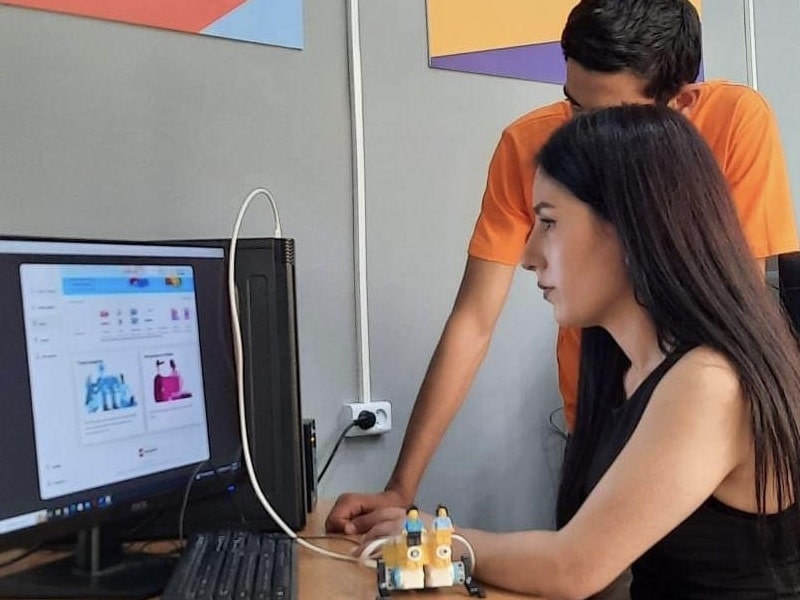A groundbreaking summit to help close the global digital divide is taking place this June. It’s the first in-person session since 2019, when it inspired transformation in a rural community in Armenia.
In the mountainous village of Shaghap, in the Armenian region of Ararat, over 170 families live in a quiet area far from urban centers. Agriculture and husbandry have long been their main source of income, with other activities complementing it: a tobacco factory, a small pastry shop, and a bed and breakfast for tourists who are eager to venture into the Armenian mountains. But the lack of new opportunities has led to the exodus of Shaghap’s youth to the capital city of Yerevan and other larger cities, where they can find other jobs and create better opportunities for their future.
The lack of opportunities was partly due to the limited Internet access available in Ararat: the whole village relied on mobile connectivity with data caps to get online. Left behind by service providers because of their remote location and costly infrastructure investment, high-speed Internet was just a dream. Entertainment options were also scarce, limited to a handful of TV channels that were also the main source of information.
But this started to change when the village came together to build a fiber community network—after learning from similar experiences in the region.
Becoming Part of a Global Movement
Driven by Kristine Gyonjyan, Director Union of Operators of Armenia, the people in Shaghap saw an opportunity when they learned about community networks during the 2019 European Community Networks Summit. The summit was led by the Internet Society and held in the neighboring country of Georgia. During the summit, people from all over the region working with community networks shared their experiences, including representatives from guifi.net in Barcelona, Sarantaporo in Greece, Suusamyr in Kyrgyzstan, and Tusheti in Georgia. The event also shared how to leverage public and private investment for these types of networks, and how to create an enabling regulatory environment allowing them to grow and thrive.
The Internet Society is helping to close the global digital divide by:
– Supporting initiatives to deploy Internet infrastructure to connect those who need it most
– Reaching areas where traditional providers don’t operate
– Supporting the development of local technical skills
People in Shaghap had thought about connecting underserved areas with fiber optic cables. Learning about the experience of others who had set up community networks made it seem more realistic. They started by kicking off conversations with members of the community, network operators, the Union of Operators of Armenia, and the Armenian government. The idea was eventually supported by the Ministry of High-Tech Industry of Armenia and the Public Services Regulatory Commission. This led to a pilot project developed by the Union of Operators of Armenia to deploy its first community network.
After delays due to local conflicts and COVID restrictions, the project finally took off in 2021. The Union of Operators of Armenia established the Community Networks Foundation to lead this project and partnered with a local network operator, Arpinet, and the Armenian Electronic Network for the infrastructure planning and use. The community installed over 18 kilometers of fiber optic cables to bring connectivity to Shaghap from the nearby village of Vedy, and then laid another two kilometers within the village to connect several homes and buildings, including the local school.
Fast Improvements

Connectivity brought the developments that the community was seeking: the school was finally able to organize online lessons for its students, allowing them to expand their learning experiences beyond the classroom. It also helped make the case for an investment by Rostelecom to create a robotics lab at the school, helping children combine the learning of new skills through the Internet with local innovation. The local pastry shop saw an increase in business and in safety: they were able to deploy video monitoring for the store, and tourists are staying longer and ordering more now that they have access to Wi-Fi there. Last but not least, people are happier with more entertainment options at home.
The improved Internet connection is also helping people with research. Peter Cob, an archeologist working for the University of Hong Kong, says they are “trying to study the human past using digital technologies… We do 3D scans of everything we excavate, and we want to make sure this gets up to the Internet and to the university for the long-term preservation, storage, and analysis of the ancient past.”

The community network sparked attention across the country too, and was featured in a news story in two different channels. Now that the connectivity model has shown it’s capable of bringing connectivity to isolated areas, there are plans to expand this solution to seven other communities near Shaghap that will connect thousands more.
Growing the Movement
After going through the experience of deploying a successful community network, Kristine is now working to share the people of Shaghap’s experience and foster collaboration during another community networks summit, this time in Armenia.
For the first time since 2019, people working with community networks in Europe are coming together to discuss the technical issues they face, enabling policy environments and financing mechanisms for these solutions, and training and learning opportunities to deploy these networks in places that are hard to reach, like the mountainous villages of Armenia.
The Connecting the Unconnected: Europe and Beyond summit will take place in Yerevan, Armenia, on 6-7 June 2023.

